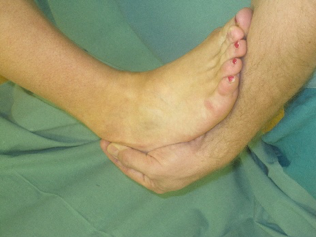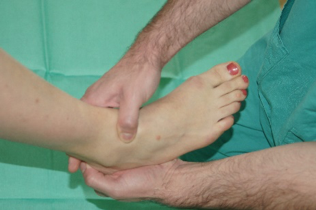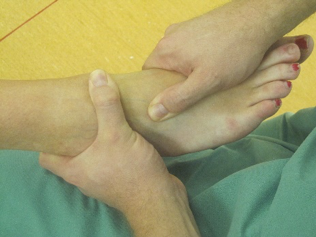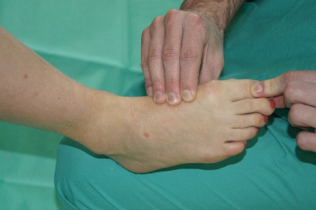Ankle motion (20°- 40°)
Examination of the ankle joint
Best examined with the knee flexed. Hold the calcaneus with one hand, invert the foot to lock the subtalar joint. Rest the foot on the forearm and place the other hand on the tibia. Dorsiflex the ankle by lifting the forearm that supports the foot.

Figure 9.Clinical photograph showing ankle movement
Subtalar motion (5°valgus, 5°varus)
Isolated subtalar joint motion is subtle. The ankle should be dorsiflexed to lock the talus and isolate the subtalar joint.
Examination of the subtalar joint
Place one hand on the tibia with a finger and thumb gently feeling the talar head. Place one hand holding the calcaneum with the foot on the forearm. Dorsiflex the ankle. Apply a varus/valgus stress and stop when the talus is felt to move.

Figure 10.Range of movement subtalar joint
Inversion and Eversion (~ 20° inversion and 10° eversion)
Combined movement of the subtalar joint, chopart’s joint and midtarsal joints
Examination of Inversion and Eversion
Examine inversion in plantarflexion and eversion in neutral
Chopart’s joint
The calcaneocuboid joint and talonavicular joint make up Chopart’s joint.
Pronation/supination movement
Examination of Chopart’s joint
Hold the hindfoot stable in neutral with one hand, with the other hand hold the midfoot, passively supinate and pronate through Chopart’s joint.

Figure 11.Range of movement of Chopart's joint
Midtarsal joints
Adduction and abduction
Examination of The midtarsal joints
Hold the hindfoot in a neutral position with one hand, hold the foot with the other hand and assess passive abduction and adduction.
First Tarsometatarsal joint
Looking for excess superior and inferior translation
Examination of the First Tarsometatarsal joint
Fix the midfoot with one hand, grasp the first metatarsal with the other hand. Passively displace the first metatarsal in a dorsal/plantar direction
First MTPJ
- Plantarflexion
- Dorsiflexion
- Varus/valgus alignment
- Grind test
Examination of the First Metatarsal Phalangeal joint.
Hold the 1stmetatarsal with one hand and hold the proximal phalanx with the other hand. Assess the joint for varus/valgus correction and dorsiflexion and plantar flexion.

Figure 12.Range of movement of 1st MTP joint